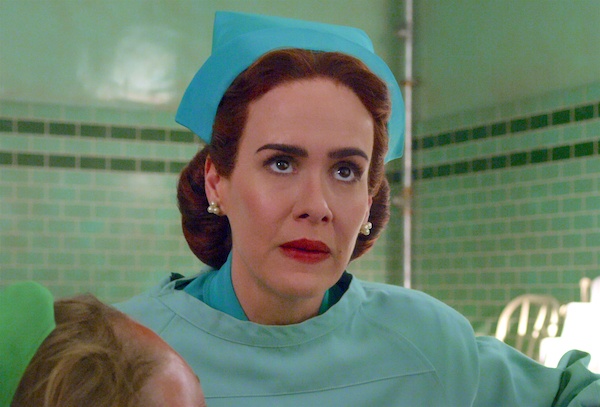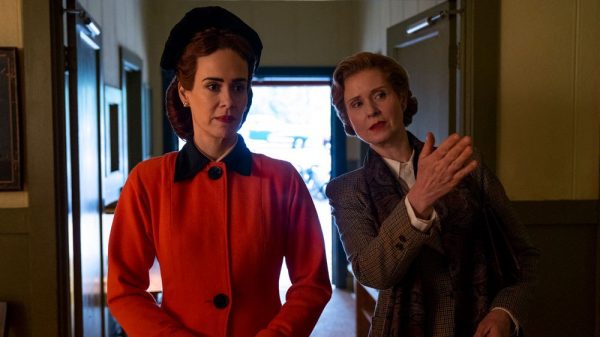TV Review: “Ratched” — A Sensational Sartorial Folly
By Peg Aloi
Ratched is lurid, violent, sexually explicit, outrageous, and has nothing whatsoever to do with Ken Kesey’s novel or Milos Forman’s award-winning film adaptation.

Sarah Paulson plays Mildred Ratched in Ratched. Photo: NETFLIX.
The latest series from producer, writer, and director Ryan Murphy is as decadent and indulgent as his previous work. Indeed, no one seems able to say no to this guy, certainly not Netflix. Like many viewers, I enjoyed Hollywood, which was loosely based on the life of Scotty Bowers, a longtime pimp to the stars who was the subject of the fascinating 2018 documentary Scotty and the Secret History of Hollywood. On the one hand, Murphy’s efforts to rewrite history and transform Hollywood into a friendlier place for gay people and people of color is admirable. On the other, his revisionism sometimes comes off as pretentious and condescending because we know it really wasn’t that way. Inequity continues to undercut the livelihoods of women and people of color. Also, this series boasts, as Murphy’s work usually does, gorgeous visuals, from stunning costumes and vintage cars to elegant sets. But the project feels a bit scattershot dramatically, even unfinished by its end. The result is that even a stellar cast (including Patti Lupone, Dylan McDermott, and Holland Taylor) couldn’t save Hollywood from feeling like a very glitzy, well-acted bit of fluff.
Murphy continues to attract some of the best talent in the business. Luminaries such as Jessica Lange, Sarah Paulson, Denis O’Hare, Kathy Bates, Lady Gaga, Adina Porter, and Evan Peters appeared regularly in American Horror Story, his popular series co-created with Brad Falchuk, which has run for eight seasons. But Murphy’s downfall can be traced to the end of his debut series Nip/Tuck (about two plastic surgeons in Miami). He has a tendency to turn away from character-driven drama and carefully constructed plots; instead, he focuses on coming up with colorful, shocking, sensational moments. The latter can be quite innovative and memorable, but they can’t sustain a sagging story that lacks a solid through line.
Nowhere have we seen this writ larger than in the ongoing anthology series American Horror Story. Indeed, the idea of an “anthology series,” while not original to Murphy, is now indelibly associated with him. The approach allows him to build shows that share loosely related themes which vary from season to season. Some of the concepts that propel American Horror Story — drawing on the same cast members but placing them in different settings or time periods — are fascinating, filled with possibility. Still, others feel as if the concept was not fully formed out of the gate, that story elements are being made up as they go along. We certainly saw this with AHS: Coven (set in contemporary New Orleans, about a coven of witches seeking their leader). Legendary pop singer Stevie Nicks, upon hearing that there was a character obsessed with her, stated publicly she would be very interested in participating in this series. Then, lo and behold, she appeared and even sang: it was really cool and delightful, but it felt tacked on. So wishy-washy and unsatisfying was the plot trajectory of Coven that the characters had to be brought back in a second anthology installment, AHS: Apocalypse, several years later. This was so that the witches could have an end-times showdown with a Satanic stand-in and a bunch of extremely well-dressed gay warlocks.
And honestly, why doesn’t Murphy stick to something like this? A super campy, beautifully designed, ridiculously over-the-top show about fashionable gay warlocks, starring the likes of Billy Porter and BD Wong? But Murphy has loftier ambitions beyond camp for its own sake, and sometimes these ambitions work out fine. I loved the first installment of Murphy’s recent anthology series Feud: Bette and Joan, which dramatized the rivalry between Bette Davis and Joan Crawford during the making of Whatever Happened to Baby Jane? and after. Starring AHS regular Jessica Lange and Bette Davis look-alike Susan Sarandon, this was a classy, riveting, and very well produced series. Then there’s the true crime explorations of American Crime Story, executive-produced by Murphy. That series debuted with the award-studded The People Vs. O.J. Simpson, followed by The Assassination of Gianni Versace. Murphy does particularly well with period pieces because it lets him indulge his appetite for grandiosity and spectacle. Now, with Ratched, which is set in 1947, he has found an opportunity work with Hollywood-style glamour and postwar tensions. He may have found a niche he’ll wallow in for a while.
But here’s the thing. Murphy also has a bad habit of, shall we say, being inspired by the work of others. Some call it homage, others shameless borrowing or even plagiarism. Whatever, there is no denying American Horror Story’s occasionally blatant visual similarities to The Blair Witch Project, Carnivàle, The Shining or The Witch, to name a few. Murphy’s newest creation, Ratched, is inspired by the evil head nurse in One Flew Over the Cuckoo’s Nest, a role played by Louise Fletcher in the celebrated film version (it won her an Oscar for Best Actress in 1976). The calm, coldhearted, perversely cruel Ratched became a pop culture reference, an icon of repression for the counterculture. The series, based on a spec script by a 25-year-old graduate student, sought to create a backstory for her, but what we get has very little connection to the character as previously encountered by readers and viewers.

Sarah Paulson (l) as Mildred Ratched and Cynthia Nixon (r) as Gwendolyn Briggs in Ratched. Photo: Saeed Adyani/Netflix
Fletcher’s Mildred Ratched was plain and severe; Sarah Paulson’s Mildred Ratched is scrupulously dressed, coiffed, and strikingly made up. Her bright lipstick, deep burgundy hair, and brightly colored suits of mustard yellow, cobalt blue, and emerald green turn her into a model fit for a Technicolor poster, not a nurse trying to run a mental institution. The beginning of the series finds Mildred traveling to a small psychiatric hospital on the California coast, driving her classy roadster along the winding road like some Hitchcockian femme fatale (indeed, the series makes more than one reference to Vertigo). We learn she had a difficult childhood full of hardship. This seems plausible, but where did she find the cash for her lavish wardrobe? She takes a room in a coastal motel run by a former jazz baby, played with delicious aplomb by Amanda Plummer. Mildred’s lack of experience with men and eventual attraction to a closeted lesbian call to mind the stylish period love story in Todd Hayne’s Carol (based on Patricia Highsmith’s 1952 novel The Price of Salt). Not to mention the mid-century fashions in that film.
The hospital Mildred was hired to work in (via some brash subterfuge) is an Art Deco marvel, all green glass and spacious rooms with elegant furnishings. The decor makes no sense, but it’s beautiful to look at — a Ryan Murphy trademark. Some dark connections in Mildred’s past are revealed. Initially, she’s motivated by compassion, even if she is cruelly manipulative. The series takes liberties in its portrait of some of the era’s questionable mental health practices. They are utilized by the brilliant but troubled head doctor, Richard Hanover (Jon Jon Briones), self-exiled from the Philippines, and his efficient head nurse (the wonderful Judy Davis). There’s a nymphomaniac nurse (Ginger & Rosa‘s Alice Englert), a nurse who was disfigured in the war, a patient who’s an unwilling subject for a frontal lobotomy, and a vivid portrayal by English actress Sophie Okonedo (Wanderlust, Wild Rose) of a complex case of multiple personality. There’s a wealthy heiress (a brilliant cameo by Sharon Stone) bent on revenge because of Dr. Hanover’s role in an accident that disabled her son. Vincent D’Onofrio plays a creepy, corrupt California governor whose reelection somehow depends on a positive relationship with the hospital; his campaign manager, played by Cynthia Nixon (a sensitive portrayal), is drawn to Mildred, who keeps her at arms’ length for several episodes.
What can I say? Ratched is all over the place. It’s lurid, violent, sexually explicit, outrageous, and has nothing whatsoever to do with Ken Kesey’s novel or Milos Forman’s award-winning film adaptation. But the actors are stunning and the visuals are delicious: 18 episodes of high-budget histrionics to immerse yourself in. I’ve seen eight of them and I must admit that I’m gonna strap myself in for 10 more.
Peg Aloi is a former film critic for the Boston Phoenix and member of the Boston Society of Film Critics. She taught film studies in Boston for over a decade. She writes on film, TV, and culture for web publications like Vice, Polygon, Bustle, Mic, Orlando Weekly, Crooked Marquee, and Bloody Disgusting. Her blog “The Witching Hour” can be found at themediawitch.com.
